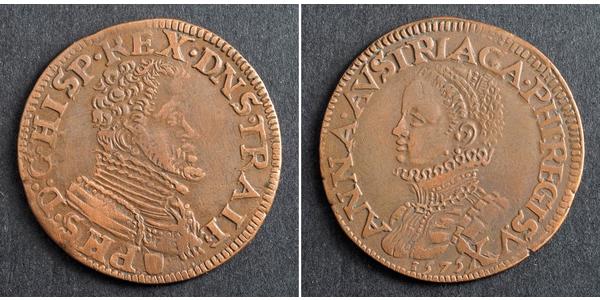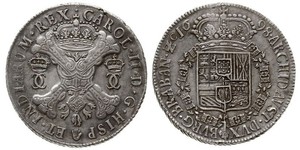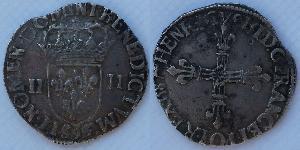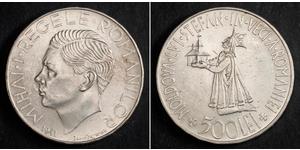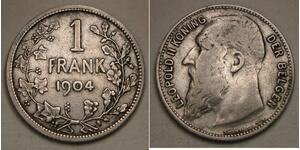(продана за $72.0)
1575, Spanish Netherlands, Utrecht. Copper "Recognition of Philip II" Medal. R!
Condition: VF+ Mint Year: 1575 Reference: Dugn.2659, vOrden790. Mint Place: Utrecht (privy mark: shield) Denomination: Medal - Recognition of Philip II as Duke of Utrecht. Material: Copper Diameter: 30mm Weight: 4.93gm
Obverse: Armoured bare and bearded bust of Philip II of Spain right. Privy mark of Utrecht (shield) below. Legend: PHS . D : G . HISP . REX . DNS . TRAIE (privy mark: shield) Translation: "Philip by the grace of God King of Spain etc., Duke of Utrecht"
Reverse: Draped bust of Anne of Austria, wife of Philip II ans Queen of Spain left. Date (1575) below. Legend: ANNA . AVSTRIACA . PHI . REGIS . VX / 1575 Translation: "The Lord is my helper!"
Philip II minted coins with his effigy in Milan, Naples, Sicily, Sardinia and in the Spanish Netherlands, while in Spain large coins only showed heraldic symbols, as in his father's time.
em>.
Philip II, King of Spain 1556-1598. Son of Emperor Charles V (King Charles I of Spain), founder of the Spanish line of Habsburg. * 1527 Valladolid, †1598 Escorial near Madrid. Philip II received from his father the following contries: in 1540 the Duchy of Milan, in 1554 the Kingdoms of Naples and Sicily and in 1555/56 the Netherlands, the Franche-Comté and Spain with its colonies. In 1580 Philip also claimed and took over Portugal. He strove for Spanish world supremacy and fought for the counter-reformation. He was married four times: Maria of Portugal (*1526, †1545 following the birth of Don Carlos), Queen Mary Tudor of England (1554, †1558), Elizabeth of Valois, daughter of King Henry II of France (1559, †1568) and finally, in 1570, Anna of Austria, daughter of Emperor Maximilian II. King Philip II fought successfully against France (1557-1559), against the Turks (Juan d'Austria's victory near Lepanto in 1571) and against Mediterranean pirates. However, his attempt to conquer England failed (destruction of the Armada in 1588, sea-battle of Cádiz in 1596), as did his efforts to subdue the revolting Netherlands (secession of the northern provinces). Philip's ongoing war efforts overstrained his financial and economic resources and eventually led to the decline of Spanish supremacy.
Anna of Austria (2 November 1549 – 26 October 1580) was Queen of Spain by marriage to her uncle, King Philip II of Spain. During her last days of life she was also briefly queen of Portugal.
Anna was the eldest daughter of Maximilian II, Holy Roman Emperor, and Maria of Spain, who were first cousins. She was born in Spain during the reign of her maternal grandfather, Emperor Charles V, but lived in Vienna from the age of four. Anna was considered her father's favorite child. The story goes that he enjoyed playing and gambling with her and once a meeting of the Estates of Hungary was postponed because Anna was sick. She received a Catholic education even though her father was sympathetic to Lutheranism.
As the eldest daughter of the Holy Roman Emperor, Anna was a desirable candidate for marriage at the European courts. Her parents thought a Spanish marriage would strengthen links between the Austrian and Spanish Habsburg families. Initially she considered her cousin Don Carlos, the only son of her maternal uncle Philip II of Spain. These plans were shattered in 1568 when Don Carlos died. Plans for a Spanish marriage were revived when Philip's third wife, Elisabeth of Valois, died in childbirth, also in 1568. As a result, Philip was left a widower with two young daughters, Isabella Clara Eugenia and Catherine Michelle. Philip planned to remarry because he no longer had a male heir. The marriage was at first opposed by many, including Pope Pius V, but it was arranged all the same.
In February 1569, Anna's engagement to her uncle Philip II was announced and in May 1570 they married by proxy. Anna traveled from Austria to Spain in the autumn of 1570 accompanied by her brothers Albert and Wenceslaus. Anna passed along the English Channel, where Elizabeth I sent her admirals, Charles Howard and William Wynter, to offer support and safe passage. They traveled through the Netherlands, where Anna was accosted by friends and relatives of Floris of Montigny, the younger brother of the executed Count of Horn. Floris had been imprisoned in Spain since 1567. Now that King Philip had entered into a new marriage, Floris' family and friends hoped for leniency. They received a promise from the future queen that she would do her utmost to free Floris; however she was unsuccessful, with Floris being strangled on the orders of the king. On 3 October Anna arrived on Spanish soil, but before she could reach the king, Floris was secretly put to death on 16 October 1570. The historian John Brewer believes that Philip had him hastily executed soon after Philip's first meeting with Anna, in which he refused to free Floris.
Upon her arrival in Spain, Anna was provided with a new household formed under the direction of the experienced and influential lady-in-waiting Margarita de Cardona, who had previously been the lady-in-waiting of her mother and who would have been known to her since her childhood in Austria. Queen Anna was described as vivid and cheerful, and managed to ease up some of the stiff atmosphere at the Spanish court. Anna busied herself mostly with needlework.
The marriage between Anna and Philip is described as happy. Besides being her father's favorite child, Anna was reportedly also Philip's most beloved wife. According to diplomats, the king was in love with his young bride. There are no records of Philip having mistresses during the time of their marriage. Anna had a personality very much like his own, and he was devoted to her. Philip was a conscientious monarch and maintained his relationship with Anna twice a week in the form of notes, as well as visiting his wife's bedchamber up to three times a day.
Anna gave birth to five children, including four sons, of whom the eldest three died before Philip, and the youngest eventually succeeded him as Philip III. Anna was also described as a good stepmother to Isabella Clara Eugenia and Catherine Michelle.
In 1580 she was in Badajoz, where the court was briefly based because of Philip II's claim to the Portuguese throne. She died there of influenza, eight months after giving birth to her last child, Maria, who outlived her mother by less than three years. Anna was initially buried in Badajoz, but her body was later transferred to El Escorial.

|
Добавив:
anonymous 2020-12-30 |
1 Франк Бельгія Срібло Леопольд II (1835 - 1909)
в групі 15 монет / 14 цін
⇑

